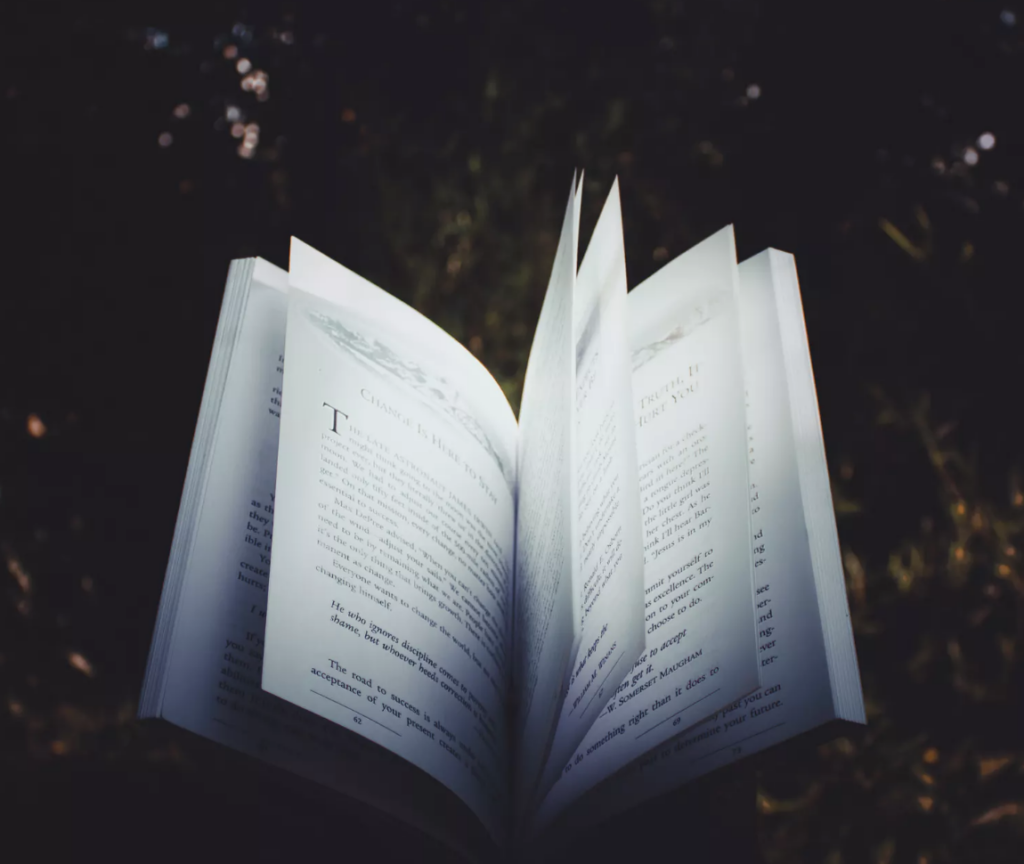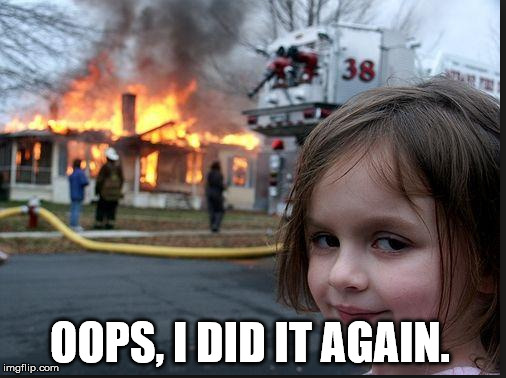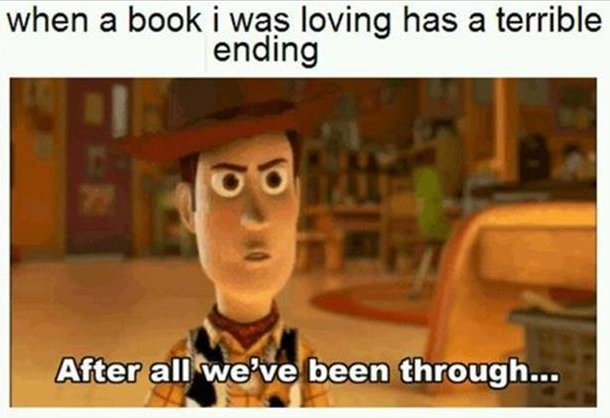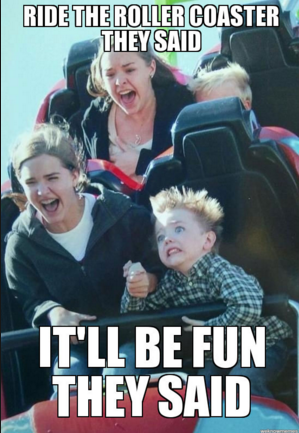
Fiction, when crafted to hit that psychic sweet spot, is highly addictive. Which is why soap operas, daytime shows (e.g. Judge Judy & Dr. Phil), and ‘reality’ programs are all going strong with no sign of slowing down.
‘Days of our Lives’ is more like ‘Decades of Our Lives.’
Drama is always in demand. In fact, we’ve even added a brand new term to our cultural lexicon to reflect this modern reality—‘binge-watching.’
Between Amazon, Netflix, Hulu, Vudu, Google Play, and the bazillion specialty channels delivered via Roku? Then add in all the devices where audiences regularly inhale ebooks, podcasts, audiobooks, blogs, videos, etc.
Let’s just say cultural appetites for stories in all their forms—from hard-boiled documentaries (Making a Murderer) all across the spectrum to the epic high fantasy fiction (Game of Thrones)—has never been so insatiable.
***I know we’ve spent the past couple posts deep-diving the publishing industry, and I PROMISE to blog about other changes ahead. Alas, I figured it was time for something a bit lighter, and yet still salient to being successful in this industry.
Good news is that audiences crave stories, and they are always hunting for their next fiction addiction no matter WHAT is going on in the publishing world.
Wired for Fiction

Every culture on every continent has used stories to pass on information of every kind for thousands of years. Why? Because human brains are wired for story.
We might not recall straight facts, but story has a way of embedding into our minds and remaining with a tenacity rivaled only by music.
There’s a reason the two (story and music), when paired together, have double the power.
Stories that resonate make all those dopamine centers light up in our brains, and the experience offers a high similar to drugs, nicotine, alcohol, sex and more drugs.
Suffice to say there IS a difference between fiction we read and soon forget and the fiction we read…then promptly forfeit eating, sleeping and showering until we’ve finished ALL THE BOOKS.
Sane people don’t stay up until 4:00 a.m. when they have to be up for work at 5:30 a.m. That’s addict behavior.
Even KIDS are not immune. Every parent knows there’s the stack of books that don’t have so much as a crack in their spines.
And then there’s that book—*coughs* Dinosaur vs. Bedtime—the one with sticky, wrinkled pages, the story we’ll read so many times it’s committed to memory.
Everyone’s memory.
But back to my music reference. With some training, patience and practice, good writers can craft excellent stories that lodge in readers’ heads exactly the same way as great music.
Granted, a song or story can become addictive by accident, which IS an option (and one I wouldn’t recommend). Then, there is the other option.
Great storytellers create addicts (fans) with intention and design.
Story as Music

It’s interesting that patients with advanced Alzheimer’s often lose the capability to remember family, friends, names, dates, but can sing a song from their youth and recall every lyric.
I never cease to be amazed how I might forget where my keys are, yet I can hear a song from thirty years ago and sing every line.
One reason some songs are addictive is because many of those great songs also tell riveting stories.
***Every Eagle’s song…pretty much ever.
The second way to make a song more likely to be addictive is to deliver in a structural way that hooks, then binds into our gray matter.
***Opening riff to Queen’s Under Pressure or Ozzy Osbourne’s Crazy Train.
Great fiction behaves in an eerily similar fashion. An incredible story idea, while a good start, isn’t quite enough.
The goal is to deliver that story idea first with a strong HOOK, then with a structure, pacing, tempo, and timing that keeps the audience hooked. All this should finish with an ending (climax) that will remain with the reader long after the final page.
Just as music must possess a certain kind of intrinsic structure in order to optimally resonate (e.g. a hook in the lyrics/chorus), superlative fiction does this as well.
We Got the Beat
Narrative structure is a critical skill. The single biggest reason most novels flop? Structure. Pretty prose does not a novel make.
Yes, today I’ll be mixing metaphors more than a 90s DJ but y’all are sharp and can keep up.
My goal is to equip you with the fundamental skills essential to honor our craft, regardless if we are plotters, pantsers, or plotsers.
Taking a Moment Here
I don’t even care to discuss plotting, outlining, pantsing, notecards, spreadsheets, serial killer walls with newspaper articles and red string, etc. Why?
Because those topics are not salient to what we’re discussing here.

HOW any writer utilizes structure is ‘process,’ thus completely up to the writer and none of my business.
I don’t care if your process involves a salt circle and channeling a spirit guide for nifty ideas so long as, at the end, there’s a finished novel that respects and values the reader’s TIME.
If your process involves body glitter while reading chicken bones and wearing a T-Rex suit…I DON’T CARE.
***Unless you’re turning out mind-blowing, amazing novels readers inhale…then PLEASE share precisely which body glitter, chicken bones (do free-range work better?) and T-Rex costume is helping you do that… because I have Prime, free shipping, and no pride.
What I do care about is that you, me, all of us respect what we do enough to learn how to do it with excellence.
Anything less is intellectual laziness and disrespectful to ourselves, our art, and our readers.
*tucks away soap box*
Don’t Want No Scrubs
No, I don’t want no scrub. A scrub is a book that can’t get no love from me. Tweeting out the messenger side of a free web site…tryin’ to holler at me.
Where was I? Oh yes…
Anyway, structure is one of those topics that I feel gets overlooked far too much, which is why Amazon is bulging with ‘scrub fiction’ that talks a good game, but, in truth, has nothing to offer readers (unless one counts buyer’s remorse).

There are a lot of workshops designed to teach new writers how to finish a ‘novel’ in four weeks or three or two or whatever. And that is great…if a writer possesses a solid understanding of structure.
If not? At the end of four weeks, you could very likely have a fifty-thousand-word word mess that no editor can fix (but that may require a salt circle to protect the unsuspecting world from it escaping).
Some of you might be in the midst of having to face some hard truths about your book. If you’ve been shopping that same book for months or years, and an agent has yet to be interested, likely structure is the problem.
If you went ahead and self-published, but sales are lackluster? Likely ‘promotion’ not the problem, product is.
Many of you might have a computer full of unfinished novels. Yes, again, structure is the most likely culprit.
Oops! I Did It Again

Been there *fist bump*. Plenty of my own bright ideas languishing in literary limbo, which was why I made it my mission to understand everything possible regarding narrative structure.
Good news is that most fiction can be fixed, although many times that requires leveling everything to the foundation and using the raw materials (original idea) to begin anew…the correct way and killing a lot of little darlings along the way.
A while back, I wrote a blog post Structure Matters: Building Great Stories to Endure the Ages that I strongly recommend.
In that article, I broke some ‘bad’ news.
Novels have rules. Sorry. They do. I didn’t make this stuff up. When we don’t follow the rules, bad things happen.
Just ask Dr. Frankenstein.
Authors who break the rules do so with a fundamental understanding of rules and reader expectations. They ‘break’ rules within certain confines.
For instance, Jimi Hendrix revolutionized the music industry and reinvented rock music by adding previously undesirable sounds (e.g. feedback distortions) as part of the actual music.
But, he first had to learn to play guitar. Then, he studied and practiced and worked with the equipment pushing and playing and testing what new sounds he could create.
Even with all the innovations, though, he STILL played what one could easily recognize as rock and roll (with an edge of blues).
Hendrix built off what audiences already knew and offered the same…but different. He didn’t come completely out of nowhere with something so odd no one recognized it as music or even had any idea what KIND of music it might have been.
It was definitely rock, but a different sort of rock.
Writers can do the same with structure and story.
Readers have expectations. Deviate too far and we will have produced a commodity so far off the standard expectations that readers won’t touch it, which is why agents won’t rep it. They are in the business of creating best-selling authors, not most-clever authors.
***FYI, one pays way better.
This said, I can tell if a writer understands structure in ten three pages. So can an agent.
Oh, and so can a savvy reader.
Doctor, Doctor!
Can’t you see I’m burning, burning…?
Yep.

Agents, editors, proofreaders, craft experts. We can tell almost immediately if a WIP is a Dumpster fire. No, we don’t need to read the whole book. Really.
Much like audiences don’t need a degree in music to know if a singer is off-key, is missing notes, or has gotten off beat, readers know when something is wrong with a book.
And they pick this up pretty quickly. No credentials as an editor required.
A lot of regular ‘readers’ sense something is…wrong. They might not have the training (and vocabulary) to articulate WHY they put a book down (e.g. tense shifting all over, head-hopping, rampant word echoes, etc.).
They’ll simply say things like, ‘I was too confused,’ or ‘I couldn’t get into it’ then move on and forget.
The Three Act Structure
Though I do teach classes on non-linear plotting, most books use the good old three-act structure and for sound reasons. First of all, Aristotelian structure has worked for a couple thousand years.
Why fix what isn’t broken?
There are variations of this three-act design, sure. But there’s something fundamentally resonant about three acts.
Beginning, middle, end.
Cut off a song halfway through a chorus, and a toddler will call foul. Stop a bedtime story in the middle. A four-year-old won’t fall for that trick.
How does it END?
We can get creative, but get crazy at our own risk.
Parallel timelines, non-linear timelines, looping timelines all have a place and work well with certain genres. But, here’s the rub. Even crazy timelines like Josh Malerman’s The Bird Box, Tana French’s In the Woods or Lianne Morairty’s Big, Little Lies can be pulled apart, the scenes lined up to create a linear three-act structure.
Also remember what your goal is when writing a story. If our end game is to sell a lot of books, then we need to entertain a LOT of people.
Get too squirrely with structure and that’s more likely to confuse readers than anything (since most readers are used to three-act structure).
If the story does gain a following, usually it’s a niche one. Nothing wrong with that, just be aware of the risks.
For example, probably way more people hated Pulp Fiction than loved it.
We’ll Be Counting Stars
Let’s stop counting dollars, let’s start counting stars….

I understand that this is not a hard and fast rule, but still fairly safe to assert good books sell better than crappy books. How, then do we write a great story?
Ideally, our story will hook hard and deep, then the tension will steadily build from the beginning to end, with only minor troughs to catch our breath. Pressure should progressively intensify until the grand finale, much like a symphony.
But for a more visceral explanation of story, I’m switching metaphors here.
I prefer to compare the larger story structure to roller coasters.
People line up for great books for the same reasons they stand in withering summer heat to ride the latest roller coaster, and even pay extra for fast passes to skip to the front.
They yearn for a THRILL.
The Thrill of It All

I want you to envision the best roller coasters, how they are put together. All thrill rides begin with an immobile metal bar that closes over your lap. No getting off the ride now (the story hook).
Then there’s an initial slow, creeping up, up, up a hill where your gut twists from fear laced with anticipation (Inciting Incident that introduces the story problem ahead), a small dip to catch your breath, and then (turning point into Act One) you’re committed to the very end when the bar unlatches.
If the biggest loop, wildest twist or tallest hill is at the beginning of the ride (story), the rest of the ride cannot help but be a complete letdown because of poor design.
Engineers know this (great writers do, too). This is why no thrill ride is even built until there is a prototype/design that satisfies investors that park patrons will LOVE it.
Writers are wise to do this as well.
I Hate You, I Love You

Great stories and great rides. We hate them and love them and hate that we love them. Now, let’s go and WRITE one 😀 .
Theme parks know it’s stupid to invest millions of dollars and countless man hours into something that by design no one will bother waiting in line to ride.
Or a ride so bad it will infuriate anyone who bothered to stand in line…who will then tell every single person they find how awful the experience was.
Engineers fundamentally understand that thrills are crafted, not accidental. They grasp that an optimally designed roller coaster gives escalating thrills—bigger and bigger hills, twists, turns, dives, climbs and loops—with fewer and fewer troughs to catch a breath.
This all inevitably leads up to the largest loop/twist/inversion that then deescalates with incrementally slower and smaller loops and turns. The ride all culminates with smooth glide home to the other side of where it all began.
Every person locked on that ride desperately wants it all to end, but they do so with a mix of terror, dread and glee. Riders stagger away, breathless. They’re simultaneously thrilled and crushed it went so quickly.
So they stand in line AGAIN (or pay big bucks for fast-passes to skip to front).
Genre expectations give us an idea of what sort of ride to build. Are we building Twirling Tea Cups for parents and grandparents to enjoy with small children? Or are we constructing a ride for globe-trotting thrill-seekers who want as close to a Near Death Experience as possible?
Same with story. When we know who our story is supposed to entertain, we then have a better idea of what they want, what they don’t yet know that they want…and how to build it 😉 .
Stitches
I thought that I’d been hooked before, but no book ever left me quite this sore. Your hooks sunk deeper than a knife, now I need Book Two to bring me back to life….

These are REAL fans…
When writers NAIL structure, they can design a similar ride—something that delivers the pain/pleasure readers crave to feel ALIVE. To SIZZLE with life!
We want readers who stay up all night (against their better judgement), who will happily endure the book-hangover and tell all their friends to get in line for the same experience.
Sure, runaway book success can happen by chance, but luck favors the prepared.
We can design stories that lock readers onto a thrilling, chilling, mind-blowing emotional roller coaster and heck of a ride.
Crafted properly, readers will be begging for ‘the ride’ to be OVER-AND-OMG-I-CANNOT-TAKE-IT-BUT-I-CANNOT-STOP-I-MUST-KNOW.
Readers will beg for your book to end…and then be depressed when it finally does. But not to worry, they’ll be right back in line and likely will bring FRIENDS!
I love hearing from you!
I also challenge you to look at the books YOU love. Study them. Which books have hooked you? What hooked you and where? How? Can you do something that is the same but different?
What are some series on Netflix or HBO or wherever that snagged you and didn’t let you go? How did they keep you watching episode after episode? Reverse engineer that.
Use that ‘goofing off’ time to STUDY.
That, and I have some classes on sale that can help as well.
Just FYI, I will have to free up space on our servers. All my classes come with a free recording. This said, I’ve put selected recordings on CLEARANCE for the next few days until new classes begin.
This not only is to help y’all get the training you need (affordable summer school), but it will open up room for the new recordings of new classes.
Please take advantage of the sale! I rarely drop prices this low.
After July 17th, these classes will no longer be for sale (and will be slated for deletion).
***I extended the sale to test the new E.E. license.
Some, I will offer again later in the year. Others? I won’t be offering again the same way (will be likely splitting them into two classes because they ran long).
Thanks so much for your support!
ON DEMAND CLEARANCE ON BRANDING & CRAFT CLASSES!
Available until July 17th, 2019
CLEARANCE Branding, Social Media & Sales Classes
ON DEMAND T.K.O. BUNDLE: Branding, Blogging & Sales for Authors
$99 (Regularly $165)
ON DEMAND Brand Boss: Branding for Authors
$35 (Regularly $55)
ON DEMAND Sales for Writers: Sell Books Not Your SOUL
$35 (Regularly $55)
ON DEMAND Blogging for Authors
$35 (Regularly $55)
Also Offering:
ON DEMAND Social Schizophrenia: Building a Brand WITHOUT Losing Your Mind
$35 (Regularly $55)
CLEARANCE Craft Classes
Plot Boss: Writing Books Readers Want to BUY!
$35 (Regularly $55)
Fiction Addiction: The ‘Secret’ Ingredient Readers Crave
$35 (Regularly $55)
Story Master: From Dream to DONE
$35 (Regularly $55)
The Art of Character: Creating Dimensional ‘People’ in Fiction
$35 (Regularly $55)
Beyond Bulletproof Barbie: Creating Strong Female Characters for a Modern World
$35 (Regularly $55)








6 comments
Skip to comment form
Thank you for that interesting and helpful post. I really enjoyed the way you likened a story to a roller-coaster. It’s a brilliant analogy. I’ve read books like that! You want to know how it all ends, but don’t want to finish the book. If feels as if you’ve lost friends you’ve made while reading.
Author
I love that analogy for myself when writing. You can FEEL when you’ve gone too long without a dive or twist and, conversely, when you might want to ease back and give the reader a breather. It helps for pacing.
I’m glad to hear you emphasizing structure, because for me at least it’s been the most challenging part of writing. I can craft a compelling image or scene, no problem. A whole long novel. Harder!
Author
Preaching to the choir. I had a stack of brilliant ideas that all crashed and burned and finally got tired of it and started studying structure (which did NOT excite me at all). All of those old “brilliant” ideas I am now working on and finishing because I know HOW to. Structure isn’t especially sexy, but it makes a HUGE difference. If you get a chance, get Plot Boss while it is on sale. I take all it took me a decade to learn and put it into a fun class you can watch at your leisure, study and take notes. And I make it fun.
As a person who loves music a little bit more than reading, this is my favorite thing you have ever posted. And I love the headline. You are brilliant. Thanks!
Author
Aww, thanks ((HUGS)).